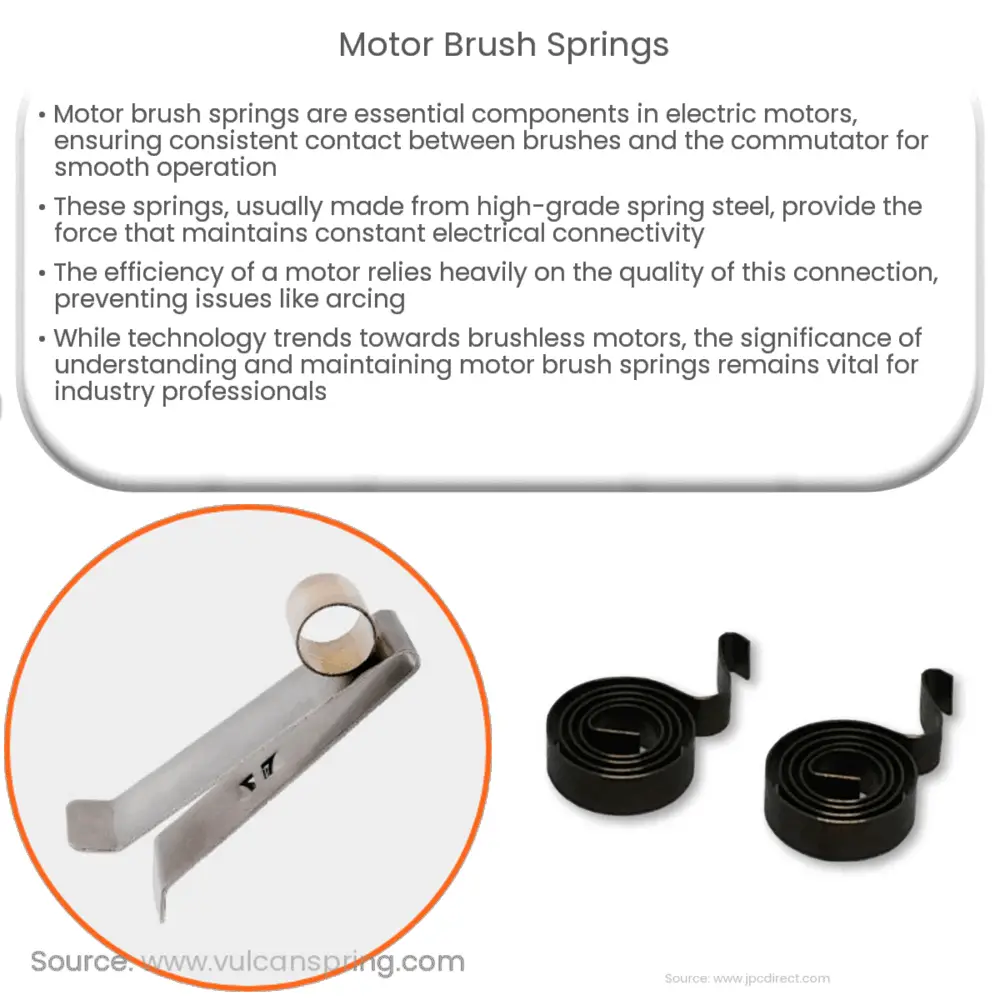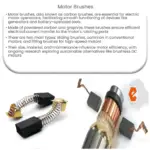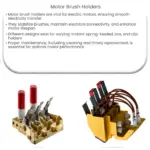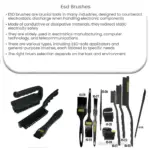Explore the role, types, and maintenance of motor brush springs in electric motors. Unveil their significance for efficient motor operation.

Introduction to Motor Brush Springs
In the world of electrical motors, motor brush springs play a crucial role in maintaining the effective operation of the device. These components might seem small, but they carry a substantial responsibility in the overall function of the motor.
What Are Motor Brush Springs?
Motor brush springs are components of electric motors designed to provide consistent contact pressure of the brushes against the commutator. They ensure optimal electrical conductivity, allowing the motor to run smoothly and efficiently. The brush and spring assembly is a critical part of an electric motor’s commutation process.
How Motor Brush Springs Work
To understand how motor brush springs work, it’s essential to first understand the purpose of brushes in an electric motor. Brushes are typically made of graphite or carbon and are used to transfer electrical current between stationary wires and rotating parts of the motor.
-
The motor brush springs push the brushes against the rotating commutator.
-
As the commutator turns, the brushes slide over its surface, transmitting electric current into the rotor windings, effectively turning them into electromagnets.
-
The electromagnets interact with the stator’s magnetic field, causing the rotor to turn, hence driving the motor.
The Importance of Motor Brush Springs
The efficiency of a motor largely depends on the quality of the connection between the brushes and the commutator. A firm, steady pressure is required for a consistent electrical connection. That’s where motor brush springs come into play. They provide the necessary force that keeps the brushes in constant contact with the commutator, facilitating continuous current transfer and preventing arcing and pitting.
The Different Types of Motor Brush Springs
There are various types of motor brush springs available, each designed for specific motor types and operating conditions. The most common ones include:
-
Constant force springs: These springs deliver a consistent force, regardless of how much they’re extended. They’re typically used in high-speed motors or those that require precise control.
-
Variable force springs: These springs exert a force that varies with their extension, making them suitable for motors operating under varying load conditions.
In the following part of this article, we will discuss in-depth the materials used for these springs, factors affecting their lifespan, and tips for maintenance. Stay tuned!
Materials Used for Motor Brush Springs
Motor brush springs are typically made from high-grade spring steel. This type of steel is specifically designed to withstand the constant stress and tension that comes with the continuous operation of electric motors. The materials must be both robust and flexible, providing consistent force without deforming or breaking over time.
Factors Affecting Lifespan of Motor Brush Springs
Several factors can affect the lifespan of motor brush springs:
-
Operating Conditions: Excessive heat and vibration can degrade springs over time. Therefore, the operating environment of the motor plays a critical role in the longevity of the springs.
-
Maintenance: Regular inspection and replacement of worn-out springs can significantly extend the lifespan of the motor.
-
Quality of Material: The quality of the spring steel used in manufacturing the springs directly impacts their lifespan.
Tips for Maintenance
Maintaining motor brush springs is an integral part of ensuring an electric motor’s longevity and efficient operation. Here are some maintenance tips:
-
Regularly inspect the springs for any signs of wear or damage. Replace any springs that appear worn or damaged.
-
Ensure the springs apply even pressure across all brushes. Uneven pressure can cause arcing and rapid wear of brushes.
-
Clean the springs regularly to prevent dust and debris accumulation, which can impede their function.
Conclusion
Motor brush springs may seem inconsequential given their size, but their role in the efficient functioning of electric motors cannot be overstated. They are integral to maintaining effective electrical connectivity, ensuring smooth operation, and prolonging the life of the motor. Understanding their function, the materials they’re made of, and their maintenance requirements is therefore essential for anyone dealing with electric motors.
While advancements in technology are gradually moving towards brushless motors, brushed motors, along with their integral components like motor brush springs, continue to play a vital role in numerous applications. The knowledge about these springs, therefore, remains crucial for engineers and professionals in related fields.




